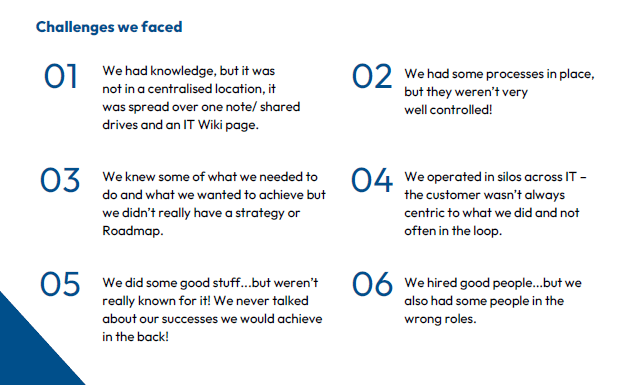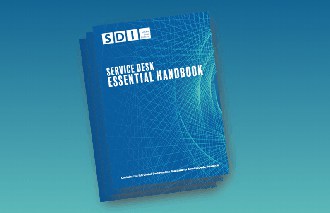
Railpen formed in 1994 during the privatisation of the railway industry, when all members and assets in the former British Rail Pension Scheme were transferred over. For our Rail members, we’re responsible for the safekeeping and investment of about £37 billion in assets as well as the administration of a number of pension schemes, including the Railways Pension Scheme, which is one of the UK’s largest and longest established pension funds.
Below is the Service Desk Certification journey Railpen have experienced so far.
Life In Railpen It “B.C” (Before Certification)
Life wasn’t always easy in Railpen IT before the SDI Certification journey, some of the challenges we faced were typical in smaller IT teams across the country.

Starting the SDI journey
After the discussion of, shall we? can we? could we? We needed an action oriented conscious decision to start and that’s why we embarked on the journey of SDI’s Certification programme.
Focus Areas:
We needed a touchpoint of where we were at. – We had our Mock Audit in June 2020 and scored an overall score of 2.56, with two concept areas below the minimum requirement.
What did we do well? -We had regular Service delivery reviews with different areas of the business , we had CAB each Wednesday to align out Changes process.
What needed improving? -Aligning these things together and collaboration across IT.
What needed implementing? – Engagement with the business and focusing on making the ITSD for any request/ action/ the central point into IT.
So what did we do?
01 First, we reviewed the mock audit findings, this not only gave us an understanding of what we needed to improve on but also where we had gaps, or in some instances no processes in place.
02 We initiated a project to help us get structure, this also provided a way to identify all the possible work and resources we would need to carry out the delivery. It was something to help convert potential work into proposed workstreams and activity.
03 Very early on we identified ‘Managing the Customer Experience’ would be an important contributor to the success of our accreditation. This was not only the highest weighted module but also an area where we were particularly challenged and had the most work to do.
04 We set up the User Experience Forum (UEF) – to engage with business and support the initiatives we were planning on implementing.
Customer Satisfaction Survey
We ran our annual Customer Satisfaction Survey (CSAT) in May 2020 with the purpose to establish a baseline of where we stood with our customers, what we were doing well and what areas we could improve on.
Our previous CSATs were quite flat, we now see we weren’t that engaging in our approach and there was little build up to the survey being issued, we also had no real follow up so it felt like a tick box exercise in more ways than one. We changed this, we spoke to our business colleagues to tell them what we were doing, we told them why this was
important to us and asked for their help. We also provided a roadmap showing them what they could expect and when. We published the results of the survey and
highlighted the key areas our colleagues told us to focus on, which was fed into our Continual Service Improvement plan (CSI). We were holding ourselves accountable to
deliver what we started. The final thing was to publish the results linking our improvements back to the key focus areas.
User Experience Forum
One of the things we needed to do was to connect more with our customers, we wanted representation from business to come and talk to us to tell us how services impacted them and how we could work better together. We kept the meeting extremely fluid from both sides. We had sponsorship for this from the CEO Executive along with a signed statement supporting Service management.

Journey Mapping, Role Profiles and Personas

Communication
New Communication Portfolio Created:
From the CSAT and UEF we took onboard feedback regarding our communications to the business. We created a new IT Service Communications portfolio, and we standardised ITSD email templates:
• Targeted distribution lists
• Purpose was to keep them simple
• No Jargon
IT Service management Toolset Upgrade
We felt our service management toolset was outdated, needed refreshing and a general overhaul. From feedback on CSAT results we designed the upgrade around
this. Previously we only used two modules effectively – Incident management and Change Management modules.
• We kept it simple, using a 1 click approach on the landing page
• ITSD now categorise and sub categorise in the back for our customers
We are now also using very effectively:
Problem, Projects, Knowledge, Contacts, Assets and Auditing, Use of event feedback on closure of tickets.
Lessons Learnt So Far
As an IT department we now have a different way of thinking and a new approach – the SDI Certification is at the forefront of the majority of each decision we make.
• Is this an improvement?
• Is this a piece of value knowledge?
• Does any current processes/ policies/ instruction require amending?
• What is the impact to the business?
We now plan, listen and engage with the business and our customers rather than diving straight in and assuming it will be ok. It’s important to tell people what you are doing and why you are doing it:
• Always do what you say you’re going to
• Never underestimate the ability to misinterpret
If you have questions about Certification or Service Improvement support from SDI
please contact us below, we love helping IT Service and Support Teams to become even more brilliant




























